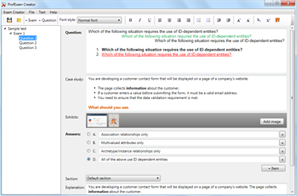File Info
| Exam | VMware HCI Master Specialist |
| Number | 5V0-21.21 |
| File Name | VMware.5V0-21.21.VCEplus.2025-03-31.48q.tqb |
| Size | 216 KB |
| Posted | Mar 31, 2025 |
| Download | VMware.5V0-21.21.VCEplus.2025-03-31.48q.tqb |
How to open VCEX & EXAM Files?
Files with VCEX & EXAM extensions can be opened by ProfExam Simulator.
Coupon: MASTEREXAM
With discount: 20%
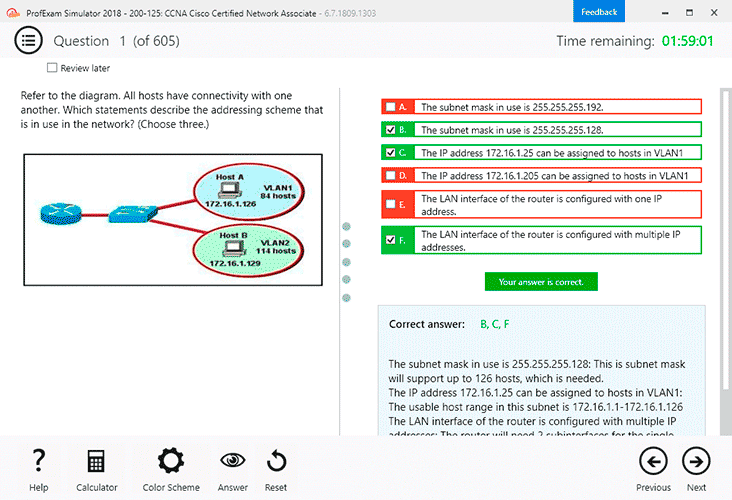

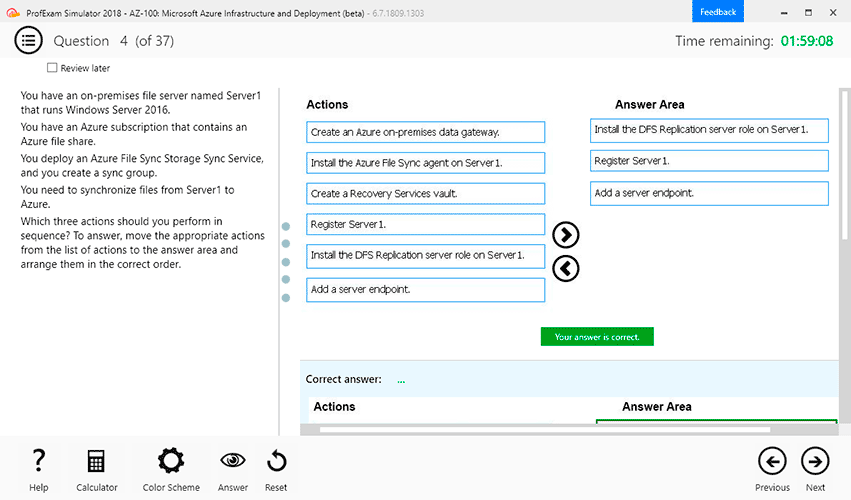
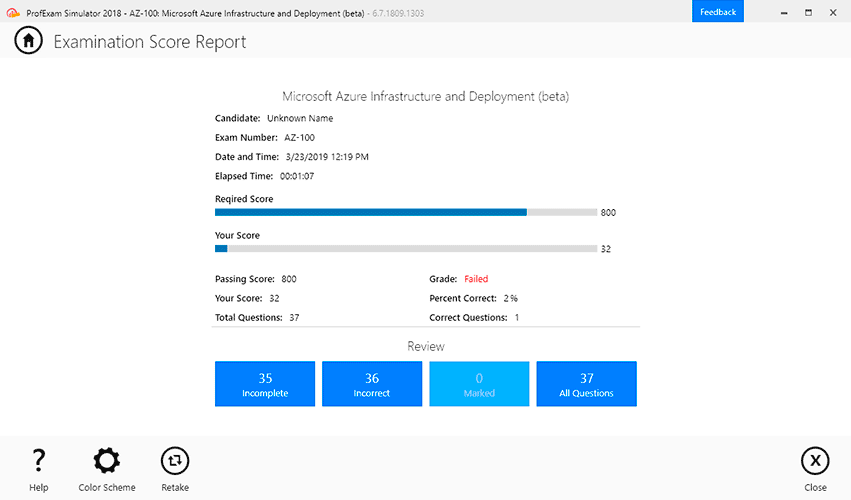
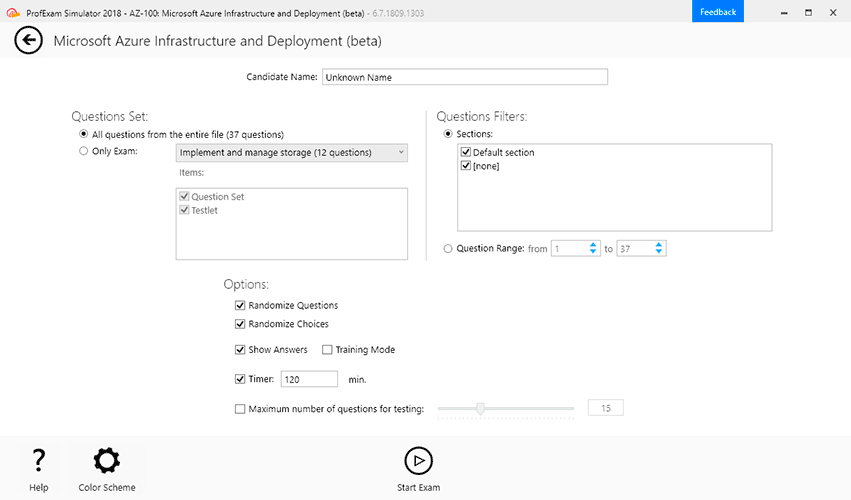

Demo Questions
Question 1
A company has engaged a consultant to upgrade an existing vSAN cluster to vSAN 7.0 U1. The company wants to ensure that the same vSAN process can be used in the future.
During the discovery phase, the consultant found the following information about the existing environment:
- The vCenter Server is currently version 7.0.
- The vSAN Cluster has the following configuration:
- vSAN version: 7.0
- Number of vSAN nodes: 6
- Encryption: enabled
- Deduplication and Compression: enabled
- Fault Domains: 1
- vSAN Capacity Utilization: 60%
- Each vSAN node has the following configuration:
- ESXi version: VMware vSphere 7.0
- CPU: 2 processors, 20 cores
- RAM: 1024GB RAM.
- Disk: 2 Cache SSDs and 6 Capacity SSDs
- Network: 4 x 10GbE
- All current hardware (which is from a single vendor) is listed on the vSAN Compatibility Guide for vSAN 7.
Which three recommendations should the consultant make to ensure that the vSAN cluster upgrade is completed? (Choose three.)
- Upgrade all vSAN nodes to VMware vSphere 7.0 U1 using the baselines capability within VMware Update Manager (VUM).
- Disable vSAN Encryption before starting the upgrade process.
- Upgrade all vSAN nodes to VMware vSphere 7.0 U1 using the images capability within VMware Update Manager (VUM).
- Set VMware Distributed Resource Scheduling (DRS) to partially automated.
- Upgrade to VMware vCenter Server 7.0 U1.
- Choose the Allow reduced redundancy option.
Correct answer: AEF
Explanation:
'vSAN build recommendations are provided through vSAN system baselines for vSphere Lifecycle Manager. These system baselines are managed by vSAN. They are read-only and cannot be customized.'https://docs.vmware.com/en/VMware-vSphere/7.0/com.vmware.vsphere.vsan.doc/GUID-E87F7946-1EDE-45EE-9087-823F7E61FABF.html 'vSAN build recommendations are provided through vSAN system baselines for vSphere Lifecycle Manager. These system baselines are managed by vSAN. They are read-only and cannot be customized.'
https://docs.vmware.com/en/VMware-vSphere/7.0/com.vmware.vsphere.vsan.doc/GUID-E87F7946-1EDE-45EE-9087-823F7E61FABF.html
Question 2
An administrator of ''vsan-prod'' cluster noticed the witness components of VMs are flagged as absent after a failed attempt to replace the vSAN Witness Host.
Which action should the administrator take to resolve this issue?
- Upgrading the vSAN on-disk format
- Running the vSAN Skyline Health check to ensure there are vSAN Object Health errors and executing the Repair Object Immediately option
- Using the RVC command: vsan.resync_dashboard ~/computers/vsan-prod
- Placing the vSAN Witness Host in Maintenance Mode and adding to the vSAN cluster
Correct answer: B
Question 3
An 8-Node vSAN Stretched Cluster (4+4+1) with a single disk group has a policy with PFTT=1 (mirrored across sites) and SFTT=1/FTM Mirroring (Local Protection) configured.
The administrator has been alerted that there is a problem with the cluster. The following has been observed:
- The vSAN Witness Host is offline.
- Two disk failures on two hosts have occurred in the preferred site.
This has resulted in a critical production virtual machine's vmdk becoming inaccessible.
Which step needs to be performed by the administrator to resolve the issue?
- Replace all failed disks on the preferred site.
- Replace the vSAN Witness Host
- Replace access to the existing vSAN Witness Host
- Replace only one failed disk on the preferred site.
Correct answer: C
Explanation:
the vSAN Witness Host offline and 2 failures in the Preferred Site. In each of the above failure cases, restoring access to the existing vSAN Witness would make the object accessible. ... Deploying a new vSAN Witness would not because the components would not be present. https://core.vmware.com/resource/vsan-stretched-cluster-guide#sec7373-sub5 the vSAN Witness Host offline and 2 failures in the Preferred Site. In each of the above failure cases, restoring access to the existing vSAN Witness would make the object accessible. ... Deploying a new vSAN Witness would not because the components would not be present. https://core.vmware.com/resource/vsan-stretched-cluster-guide#sec7373-sub5
Question 4
An administrator is tasked to create a custom storage policy for workloads and is including additional disk stripes while defining the storage policy.
What is the main purpose of this practice?
- To increase available storage space
- To set a failure tolerance
- To improve performance
- To reconstruct corrupted data
Correct answer: C
Explanation:
https://blogs.vmware.com/virtualblocks/2016/09/19/vsan-stripes/ Striping may help performance if certain virtual machines are I/O intensive and others are not.The ''number of disk stripes per object'' storage policy rule attempts to improve performance by distributing data contained in a single object (such as a VMDK) across more capacity devices.https://blogs.vmware.com/virtualblocks/2021/01/21/stripe-width-improvements-in-vsan-7-u1/ https://blogs.vmware.com/virtualblocks/2016/09/19/vsan-stripes/ Striping may help performance if certain virtual machines are I/O intensive and others are not.
The ''number of disk stripes per object'' storage policy rule attempts to improve performance by distributing data contained in a single object (such as a VMDK) across more capacity devices.
https://blogs.vmware.com/virtualblocks/2021/01/21/stripe-width-improvements-in-vsan-7-u1/
Question 5
An architect collected the below technical requirements from the customer during a vSAN cluster design workshop:
- Maximize the vSAN datastore usable capacity.
- Deduplication and compression are required to help utilize available capacity efficiency.
- Ensure the highest level of resiliency wherever possible.
Which disk group configuration should the architect include in the design?
- One disk group per host, with one cache tier flash disk and four capacity tier flash disks.
- Two disk groups per host, each with one cache tier flash disk and four capacity tier flash disks.
- Two disk groups per host, each with one cache tier flash disk and six capacity tier flash disks.
- Two disk groups per host, each with one cache tier flash disk and six capacity tier magnetic disks.
Correct answer: C
Question 6
During a vSAN design workshop, a customer expressed a requirement to decommission an existing enterprise NAS device that provides iSCSI services for a clustered application.
Based on the current state analysis, the following information was noted:
- Current utilization is 500 LUNs.
- All clustered workloads are configured for Multiple Connections per Session.
- LUN sizes range between 10 TB to 30 TB.
What should the architect state regarding the requirements?
- All requirements can be satisfied without any change.
- Only single connection per session is supported.
- The number of LUNs require additional licensing.
- It is a best practice to maintain a LUN size of 8 TB.
Correct answer: B
Explanation:
https://kb.vmware.com/s/article/57344 https://kb.vmware.com/s/article/57344
Question 7
An administrator has noticed that a number of the virtual machines in the preferred site are showing as either failed or partitioned.
In which two ways would the administrator expect the virtual machines to respond? (Choose two.)
- They will be disconnected.
- They will be restarted in the secondary site.
- They will be restarted at the preferred site.
- They will be powered off.
- They will be removed from inventory.
Correct answer: BD
Explanation:
https://core.vmware.com/resource/vsan-stretched-cluster-guide#site-failure-or-network-partitions https://core.vmware.com/resource/vsan-stretched-cluster-guide#site-failure-or-network-partitions
Question 8
An administrator notes that the Data-At-Rest Encryption keys have expired.
Which action is needed to resolve this situation?
- Add a new Standard Key Provider at the vSAN cluster level
- Generate new encryptions keys at the vSAN cluster level
- Add an additional KMS at the vCenter server level
- Generate new encryptions keys at the vCenter server level
Correct answer: B
Explanation:
https://docs.vmware.com/en/VMware-vSphere/8.0/vsan-administration/GUID-15393A27-5F38-4814-94E0-ED37A7E65249.html https://docs.vmware.com/en/VMware-vSphere/8.0/vsan-administration/GUID-15393A27-5F38-4814-94E0-ED37A7E65249.html
Question 9
In a stretched vSAN cluster, how is Read Locality established after fail over to the secondary site?
- 100% of the reads comes from vSAN hosts on the local site
- 50% of the reads comes from vSAN hosts on the local site
- 100% of the reads comes from vSAN hosts on the remote site
- 50% of the reads comes from vSAN hosts on the remote site
Correct answer: C
Explanation:
In the event of a failure or maintenance event, the virtual machine is restarted on the remote site. The 100% rule continues in the event of a failure. This means that the virtual machine will now read from the replica on the site to which it has failed over. One consideration is that there is no cached data on this site, so cache will need to warm for the virtual machine to achieve its previous levels of performance. In the event of a failure or maintenance event, the virtual machine is restarted on the remote site. The 100% rule continues in the event of a failure. This means that the virtual machine will now read from the replica on the site to which it has failed over. One consideration is that there is no cached data on this site, so cache will need to warm for the virtual machine to achieve its previous levels of performance.
Question 10
In a vSAN stretched cluster, which value must be set in the vSAN policy if there is no requirement for data mirroring across sites?
- SFTT = 0
- SFTT = 1
- PFTT = 1
- PFTT = 0
Correct answer: D
Explanation:
PFTT can be seen as ''site failures'', and you can always only tolerate 1 at most. SFTT can be seen as host failures, and you can define this between 0 and 3 https://www.yellow-bricks.com/2018/03/19/vsan-stretched-cluster-pftt-and-sftt-what-happens-when-a-full-site-fails-and-multiple-hosts-fail/ PFTT can be seen as ''site failures'', and you can always only tolerate 1 at most. SFTT can be seen as host failures, and you can define this between 0 and 3 https://www.yellow-bricks.com/2018/03/19/vsan-stretched-cluster-pftt-and-sftt-what-happens-when-a-full-site-fails-and-multiple-hosts-fail/

